Snowdonia
Author: Tony Boydell
Publisher: Asmodee/Lookout Games
Year: 2012
review by

| x |
|
|
|
|
|
|
|
|
|
|
|
|
|
|
|
|
|
|
|
|
|
|
|
|
|
|
|
|
|
|
|
|
|
|
|
|
|
|
|
|
|
|
|
|
|
|
|
|
|
|
|
|
|
|
|
|
|
|
|
|
|
 |
We’re going back in time to build the railway which will make the summit of Mountain Snowdon, the highest of Wales, accessible to the general public. The original railway was built at the end of the 19th century, and the goal of the game is to repeat this famous feat. The players do this by running their own building company, consisting of a maximum of 4 workers.
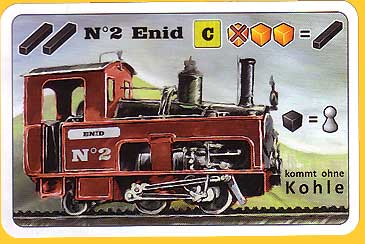
|
|
|
| x |
|
|
|
|
|
|
|
|
|
|
|
|
|
|
|
|
|
|
|
|
|
|
|
|
|
|
|
|
|
|
|
|
|
|
|
|
|
|
|
|
|
|
|
|
|
|
|
|
|
|
|
|
|
|
|
|
|
|
|
|
|
|
According to well-known tradition the game board is placed in the middle of the table. The board, however, is used only for administrative purposes, the actual track building takes place around the edges of the board. Station cards and rubble annex track cards are used to construct the railway route; they all show several building sites apart from the occasional rubble. Before the rubble cards can be transferred to track the terrain the rubble on it first needs to be excavated. Each rubble and station card shows a number which indicates how much rubble -small brown cubes- must be placed on it.
|
|
|
x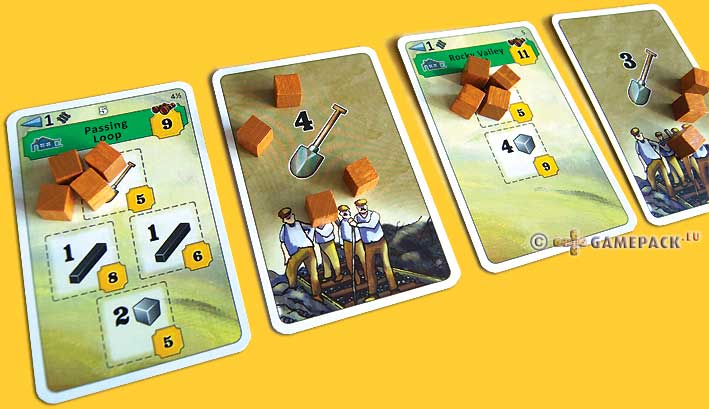 |
|
|
| x |
|
|
|
|
|
|
|
|
|
|
|
|
|
|
|
|
|
|
|
|
|
|
|
|
|
|
|
|
|
|
|
|
|
|
|
|
|
|
|
|
|
|
|
|
|
|
|
|
|
|
|
|
|
|
|
|
|
|
|
|
|
|
Each player receives four worker pawns and a number of cubes in his player colour. One of the workers is placed as surveyor on the Llanberis station on the game board. During the game, this surveyor can be moved up the mountain, from station to station, thereby scoring an increasing amount of points. A worker immediately takes refuge in the pub, getting active only when paid for.
|
|
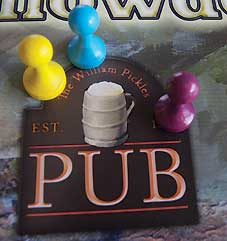 |
|
|
| x |
|
|
|
|
|
|
|
|
|
|
|
|
|
|
|
|
|
|
|
|
|
|
|
|
|
|
|
|
|
|
|
|
|
|
|
|
|
|
|
|
|
|
|
|
|
|
|
|
|
|
|
|
|
|
|
|
|
|
|
|
|
|
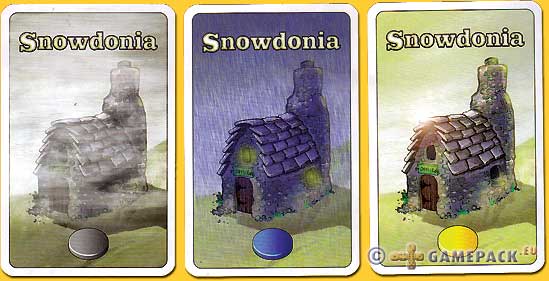
|
|
Locomotives can be bought, and these are placed next to the game board. From the stack of contract cards three are placed face down on their designated spots. The back side of the cards show what the weather will be for the upcoming rounds, indicated by wooden discs. The weather plays an important role in this game, determining the pace that the players can remove rubble and build railway track and stations.
|
|
|
| x |
|
|
|
|
|
|
|
|
|
|
|
|
|
|
|
|
|
|
|
|
|
|
|
|
|
|
|
|
|
|
|
|
|
|
|
|
|
|
|
|
|
|
|
|
|
|
|
|
|
|
|
|
|
|
|
|
|
|
|
|
|
|
‘Snowdonia’ is played over a number of rounds, until the railway has been built to Yr Wyddfa station. Each round consists of a number phases, where of course the assignment of the two and sometimes three workers and the subsequent action resolving are the most important ones. The other phases are of rather administrative nature and deal with things like adjusting the weather and refilling the resources.
|
|
|
| x |
|
|
|
|
|
|
|
|
|
|
|
|
|
|
|
|
|
|
|
|
|
|
|
|
|
|
|
|
|
|
|
|
|
|
|
|
|
|
|
|
|
|
|
|
|
|
|
|
|
|
|
|
|
|
|
|
|
|
|
|
|
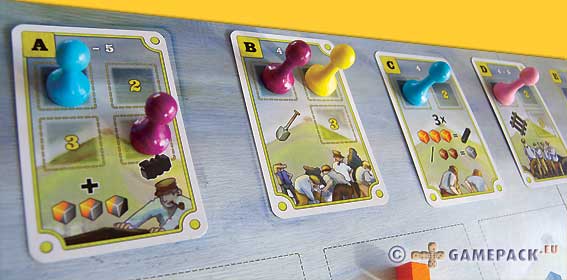 |
|
|
| x |
|
|
|
|
|
|
|
|
|
|
|
|
|
|
|
|
|
|
|
|
|
|
|
|
|
|
|
|
|
|
|
|
|
|
|
|
|
|
|
|
|
|
|
|
|
|
|
|
|
|
|
|
|
|
|
|
|
|
|
|
|
|
A player can choose out of seven actions for his worker, and for almost all actions the number of spaces is limited, and dependent on the number of players. The actions are logically ordered on the game board. When all workers one by one have been placed in a players’ turn, the actions are resolved in alphabetical order. Building requires resources, and these are available at the stockyard There are three types of resources: iron, stone and coal, drawn blindly each round. For each worker placed at the stockyard the player may take three resource cubes, but only one coal. With the excavation action rubble cubes may be cleared and placed in the personal supply. Clearing away rubble of course starts at Llanberis and continues up the mountain. The number of cubes that may be taken depends on the weather. At the mill three iron cubes can be changes into one steel bar, and two rubble into one stone.
|
|
|
| x |
|
|
|
|
|
|
|
|
|
|
|
|
|
|
|
|
|
|
|
|
|
|
|
|
|
|
|
|
|
|
|
|
|
|
|
|
|
|
|
|
|
|
|
|
|
|
|
|
|
|
|
|
|
|
|
|
|
|
|
|
|
|
With the building action the steel bars can be used to build track; the first rubble card up the mountain that has all rubble removed may now be turned to its track side, and a cube in the player’s colour is placed on it. The points for it will be scored at the end of the game.
|
|
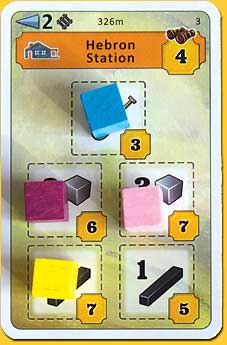 |
|
|
| x |
|
|
|
|
|
|
|
|
|
|
|
|
|
|
|
|
|
|
|
|
|
|
|
|
|
|
|
|
|
|
|
|
|
|
|
|
|
|
|
|
|
|
|
|
|
|
|
|
|
|
|
|
|
|
|
|
|
|
|
|
|
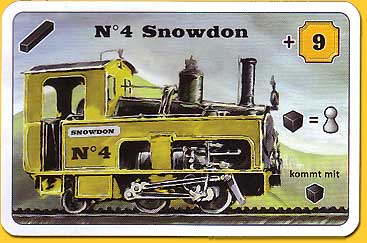 |
When the way to a station is cleared from rubble, the build action can be used to build parts of the station with stone or steel. Later in the game, this action also allows a player to buy a locomotive. When a locomotive has been bought, it enables the player to hire the worker from the pub for one coal and use the worker during the current round, after which it returns to the pub. Almost all locomotives offer advantages for certain actions; one locomotive scores points at the end of the game.
|
|
|
| x |
|
|
|
|
|
|
|
|
|
|
|
|
|
|
|
|
|
|
|
|
|
|
|
|
|
|
|
|
|
|
|
|
|
|
|
|
|
|
|
|
|
|
|
|
|
|
|
|
|
|
|
|
|
|
|
|
|
|
|
|
|
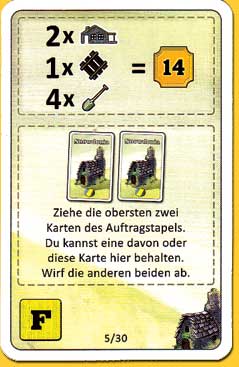 |
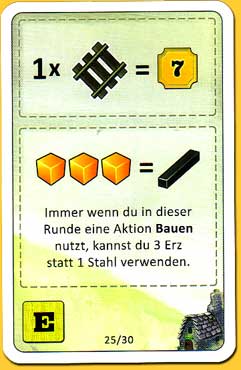 |
|
The contract cards are also essential for scoring. These can be obtained at the site office. Three cards are on display, and the player may take one for free. All contract cards are unique and have a one-time advantage during the game, and score bonus points at the end of the game when the indicated condition has been fulfilled, like building an x-number of tracks, or excavating x-rubble cubes. Finally a player may move the surveyor. The player’s surveyor pawn is moved one station up the mountain, one step closer to the summit, where the surveyor is worth a 21 points.
|
|
|
| x |
|
|
|
|
|
|
|
|
|
|
|
|
|
|
|
|
|
|
|
|
|
|
|
|
|
|
|
|
|
|
|
|
|
|
|
|
|
|
|
|
|
|
|
|
|
|
|
|
|
|
|
|
|
|
|
|
|
|
|
|
|
|
When all actions have been taken, the weather is adapted by restocking new bonus cards. The weather is always forecasted for 3 rounds: sun, rain or fog. Sun improves the worker’s productivity, rain decreases it, while fog completely blocks the rubble clearing, track laying and station building actions. At the end of the round the stockyard is refilled by drawing resource cubes at random from the supply bag. During this draw so-called white event cubes may be drawn, that are placed on a separate track. These events must be resolved immediately, and may cause an acceleration in the railway building. The possibility to buy locomotives is also triggered by an event.
|
|
|
| x |
|
|
|
|
|
|
|
|
|
|
|
|
|
|
|
|
|
|
|
|
|
|
|
|
|
|
|
|
|
|
|
|
|
|
|
|
|
|
|
|
|
|
|
|
|
|
|
|
|
|
|
|
|
|
|
|
|
|
|
|
|
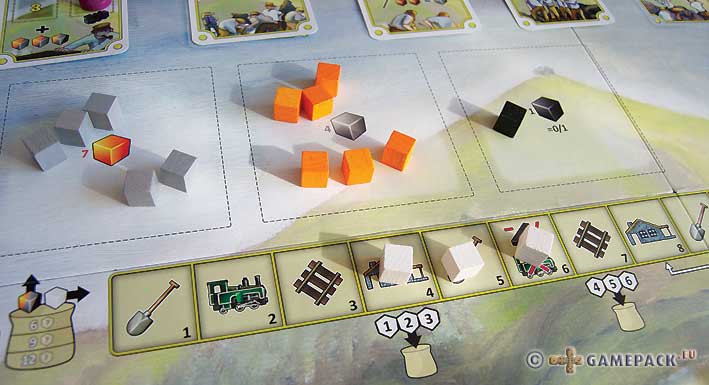 |
|
|
| x |
|
|
|
|
|
|
|
|
|
|
|
|
|
|
|
|
|
|
|
|
|
|
|
|
|
|
|
|
|
|
|
|
|
|
|
|
|
|
|
|
|
|
|
|
|
|
|
|
|
|
|
|
|
|
|
|
|
|
|
|
|
| At the end of the game victory points are scored in five categories: stations, tracks, completed contracts cards, the locomotive, and the position of the surveyor. The player with the highest total wins the game. |
|
|
| x |
|
|
|
|
|
|
|
|
|
|
|
|
|
|
|
|
|
|
|
|
|
|
|
|
|
|
|
|
|
|
|
|
|
|
|
|
|
|
|
|
|
|
|
|
|
|
|
|
|
|
|
|
|
|
|
|
|
|
|
|
|
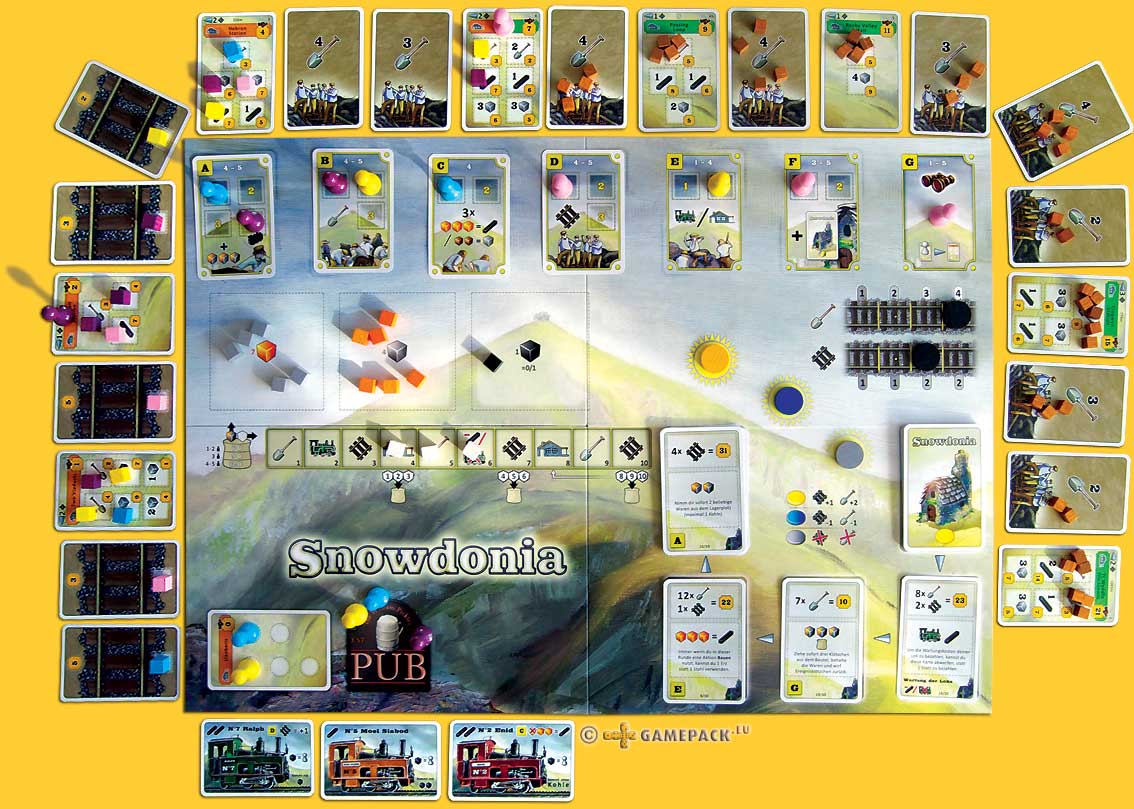 |
| x |
|
|
| x |
|
|
| x |
|
|
 |
|
|
|
|
|
|
|
|
|
|
|
|
|
|
|
|
|
|
|
|
|
|
|
|
|
|
|
|
|
|
|
|
|
|
|
|
|
|
|
|
|
|
|
|
|
|
|
|
|
|
|
|
|
‘Snowdonia’ is a typical worker placement game; the players place there workers as best as possible on spaces that are only limited available. There are a lot of this kind of games nowadays, so the question may arise whether this game adds anything new at all. The answer to this question is a clear ‘yes’, but with the additional remark that ‘Snowdonia’ is not everyone’s game.
|
|
|
| x |
|
|
|
|
|
|
|
|
|
|
|
|
|
|
|
|
|
|
|
|
|
|
|
|
|
|
|
|
|
|
|
|
|
|
|
|
|
|
|
|
|
|
|
|
|
|
|
|
|
|
|
|
|
|
|
|
|
|
|
|
|
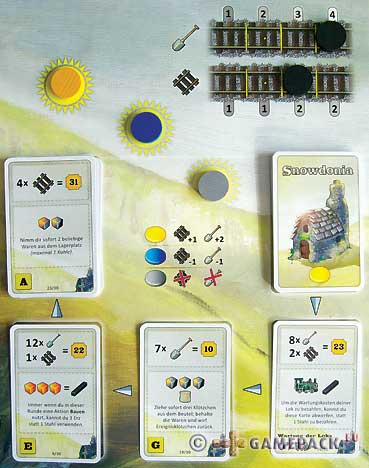 |
|
The basic principle of obtaining resources and turning them into victory points is very basic. When this would be all then ‘Snowdonia’ could be qualified as a very mediocre game. However, the events, the locomotives and the Welsh weather give the game its own unique flavor. No workers have to be fed and the resource-to-victory-points conversion is fairly linear, so painful ‘turn sequence errors’ can be easily avoided, encouraging a typical intuitive playing style.
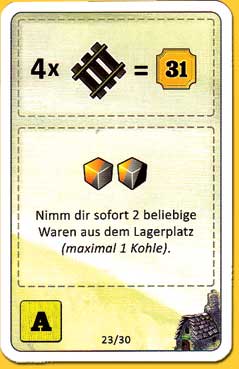
|
|
|
| x |
|
|
|
|
|
|
|
|
|
|
|
|
|
|
|
|
|
|
|
|
|
|
|
|
|
|
|
|
|
|
|
|
|
|
|
|
|
|
|
|
|
|
|
|
|
|
|
|
|
|
|
|
|
|
|
|
|
|
|
|
|
|
It's no game for players though that want to analyze and plan all their moves in detail, but one that plays nicely away in about an hour or so. It’s also a game that is quite easy to teach, with a lot of theme to go with the explanation. Sometimes the theme falls short when explaining why the game itself starts to build track, but an inventive explainer will find a way around this! Another positive thing is that the game plays very smoothly with all number of players. With any number of players, there are always useful actions remaining.
|
|
 |
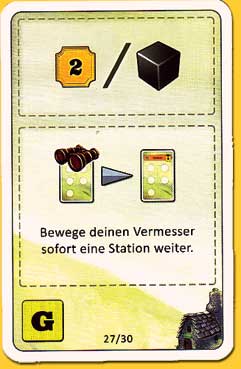 |
|
|
| x |
|
|
|
|
|
|
|
|
|
|
|
|
|
|
|
|
|
|
|
|
|
|
|
|
|
|
|
|
|
|
|
|
|
|
|
|
|
|
|
|
|
|
|
|
|
|
|
|
|
|
|
|
|
|
|
|
|
|
|
|
|
‘Snowdonia’ may not add too much for people that already have a large collection of this type in their closet, but at least it’s worth a try. Players looking for a worker placement game, but finding games like ‘Caylus’ or ‘Agricola’ a bit too much work for a game, ‘Snowdonia’ will be their kind of thing. ‘Snowdonia’ has turned the hard labour of railway building into quite a nice and smooth game. And there’s no other game in which we can blame our eventual loss to the really really bad Welsh weather!
© 2013 Edwin van de Sluis
Snowdonia, Tony Boydell, Asmodee / Lookout Games, 2012 - 1 to 5 players, 10 years and up, 30-90 minutes
|
|
|
  |
|
|
|
|
|
|
|
|
|
|
|
|
|
|
|
|
|
|
|
|
|
|
|
|
|
|
|
|
|
|
|
|
|
|
|
|
|
|
|
|
|
|
|
|
|
|
|
|
|
|
|
|
  |
|
|
|
|
|
|
|
|
|
|
|
|
|
|
|
|
|
|
|
|
|
|
|
|
|
|
|
|
|
|
|
|
|
|
|
|
|
|
|
|
|
|
|
|
|
|
|
|
|
|
|
|
  |
|
|
|
|
|
|
|
|
|
|
|
|
|
|
|
|
|
|
|
|
|
|
|
|
|
|
|
|
|
|
|
|
|
|
|
|
|
|
|
|
|
|
|
|
|
|
|
|
|
|
|
|
  |
It's an original mechanism, that the game itself can clear rubble and lay track and this way speed up the game |
|
|
  |
|
|
| x |
|
|
|
|
|
|
|
|
|
|
|
|
|
|
|
|
|
|
|
|
|
|
|
|
|
|
|
|
|
|
|
|
|
|
|
|
|
|
|
|
|
|
|
|
|
|
|
|
|
|
|
|
|
|
|
|
|
|
|
|
|
| x |
|
|
|
|
|
|
|
|
|
|
|
|
|
|
|
|
|
|
|
|
|
|
|
|
|
|
|
|
|
|
|
|
|
|
|
|
|
|
|
|
|
|
|
|
|
|
|
|
|
|
|
|
|
|
|
|
|
|
|
|
|
 |
|
|
|
|
|
|
|
|
|
|
|
|
|
|
|
|
|
|
|
|
|
|
|
|
|
|
|
|
|
|
|
|
|
|
|
|
|
|
|
|
|
|
|
|
|
|
|
|
|
|
|
|
 |
|
|
|
|
|
|
|
|
|
|
|
|
|
|
|
|
|
|
|
|
|
|
|
|
|
|
|
|
|
|
|
|
|
|
|
|
|
|
|
|
|
|
|
|
|
|
|
|
|
|
|
|
| x |
|
|
|
|
|
|
|
|
|
|
|
|
|
|
|
|
|
|
|
|
|
|
|
|
|
|
|
|
|
|
|
|
|
|
|
|
|
|
|
|
|
|
|
|
|
|
|
|
|
|
|
|
|
|
|
|
|
|
|
|
|
 |
|
|
|
|
|
|
|
|
|
|
|
|
|
|
|
|
|
|
|
|
|
|
|
|
|
|
|
|
|
|
|
|
|
|
|
|
|
|
|
|
|
|
 |
|
|
|
|
|
|
|
|
|
|
|
|
|
|
|
|
|
|
|
|
|
|
|
|
|
|
|
|
|
|
|
|
|
|
|
|
|
|
|
|
|
|